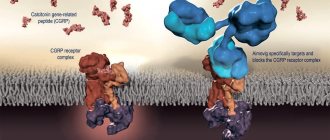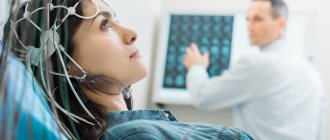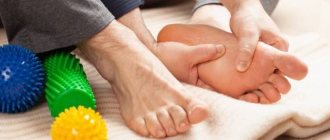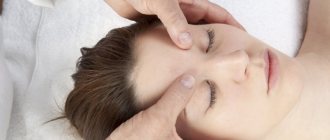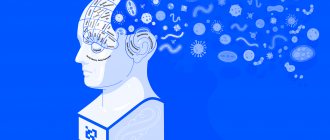The pathological process is registered in 9% of representatives of the stronger half of humanity. For men, hereditary predisposition plays an important role - almost 70% of patients have a history of relatives with a similar disease. The clinical manifestations of the disease are practically no different from the symptoms in women: with the appearance of throbbing pain on one side of the head, increased irritability, photophobia, weakness and further spread of cephalgia.
What is migraine
Migraine is a neurological disorder characterized by unilateral headaches. In some cases, it is accompanied by a set of concomitant vegetative symptoms. Because of them, migraine can be confused with other diseases.
The disease occurs more often in women and can be hereditary. There is a rare type of hemiplegic migraine that is associated with changes in genes on chromosomes 1, 2, and 19. But the role of these pieces of genetic material in the formation of common migraines is still being studied.
Not every headache fits the definition of a migraine. Usually the pathology occurs unilaterally, and the intensity of pain varies. The first signs appear on average at the age of 30 and gradually progress. But there have been rare cases of migraine headaches appearing in children as young as 3 years old. Moreover, boys suffer from migraines more often than girls. And with age, this ratio changes in favor of women.
The exact causes of the pathology are unknown, but it is considered a multifactorial disease. The peculiarity of the course of the pathology is that in women, as menopause approaches, the condition may worsen. But after menopause it stabilizes and the symptoms gradually disappear.
Treatment
There is no cure, but your doctor can help you manage it so you suffer less from it and treat symptoms when they appear. Treatment may also help make your migraines less severe.
Your treatment plan depends on:
- Your age
- How often do you suffer from migraines?
- Like
- How severe it is, depending on how long it lasts, how much pain it causes, and how often it prevents you from going to school or work
- Whether it is accompanied by nausea and vomiting and other symptoms
- Do you have any other medical conditions and what medications are you taking?
Your treatment plan may include the following combination:
- Migraine remedies
- Lifestyle changes, including managing stress and preventing migraines
- Pain medications such as NSAIDs or acetaminophen
- Medicines you take daily to prevent headaches and reduce the frequency of headaches
- Medicines you take as soon as your headache starts to keep the pain from getting worse and to help relieve the symptoms.
- Medicines that help with nausea or vomiting
- hormonal therapy if there is suspicion that the disease is related to your menstrual cycle
- consulting
- alternative methods that may include biofeedback, meditation, acupressure, or acupuncture
Migraine remedies
There are some methods you can try at home that may also help relieve the pain: Lie down in a quiet, dark room. Massage your scalp or temples. Place a cold cloth on your forehead or neck. Many people also use herbal home remedies to relieve migraines.
Medicines
Medicines can be used to either prevent migraines from occurring or treat them once they occur. You may feel better by taking over-the-counter medications. However, if such drugs are not effective, your doctor will decide to prescribe other drugs.
This will depend on the severity of your migraine and whether you have any other medical conditions. Treatment options can focus on both prevention and treatment during an attack.
Headache from medication overuse
Frequent, chronic use of any type of headache medication can cause what is called overuse. People with migraines are at higher risk of developing this complication.
As you determine how to manage your pain, talk to your doctor about how often you take your medications and alternative remedies.
Surgical methods of treatment
There are several surgical procedures that have been used to treat migraines. However, they have not been approved by the US Food and Drug Administration. These methods include neurostimulation procedures and trigger site decompression surgery (MTSDS).
The American Migraine Foundation encourages anyone considering surgical treatment to see a neurologist (headache specialist) who is board-certified in the field.
Neurostimulation surgeries
During these operations, the surgeon inserts electrodes under the skin. Electrodes provide electrical stimulation to specific nerves. Several types of stimulants are used today:
- occipital nerve stimulators
- deep brain stimulants
- vagus nerve stimulants
- sphenopalatine ganglion stimulators
Insurance is rarely provided for stimulants. Research continues regarding the expected role of neural stimulation in the treatment of headaches.
Migraine Trigger Site Decompression Surgery (MTSDS)
This surgical procedure involves releasing nerves around the head and face that may be triggers for chronic migraines. Botox injections are typically used to identify the trigger nerves involved during a migraine attack. During sedation, the surgeon deactivates or decompresses isolated nerves. Typically, such operations are performed by plastic surgeons.
The American Migraine Society does not endorse treatment with these methods. They recommend that anyone considering such surgery first consult with a specialist to identify possible risks.
Such surgeries are considered experimental until further research proves they work consistently and are safe. However, they may have a role for people with chronic migraine who have not responded to other treatments.
Forms of migraine
There are two main forms of the disease. If a headache begins suddenly without previous symptoms, it is considered a migraine without aura. The appearance of visual, olfactory or other disturbances within 60 minutes before a headache attack is called an aura. Moreover, each person suffering from this disease can experience both forms alternately.
The disease can be episodic, with attacks occurring rarely. But if left untreated, the disease becomes chronic. This form includes options in which headaches occur more than 15 days a month for any 3 months over the last six months. Sometimes headache attacks with chronic migraine do not meet all the criteria for pathology and are more reminiscent of tension headaches.
There are different types of migraine:
- retinal migraine – pain is accompanied by blurred vision, sometimes even temporary blindness occurs in one eye;
- periodic syndromes of childhood are headaches in children that, by most criteria, resemble migraines; they usually then develop into a full-fledged disease;
- abdominal migraine – pain in the abdomen occurs before or simultaneously with a headache attack. Children may experience vomiting or nausea beforehand.
- basilar migraine
- hemiplegic migraine
- aura without migraine
Why does migraine occur?
Neurology describes more than two hundred types of headaches of various origins. Broadly speaking, they are divided into two groups. Primary cephalgia is not associated with any diseases, secondary ones are symptomatic.
Migraine is a primary headache. It is considered a neurovascular syndrome and has long been thought to result from irritation or compression of the neurovascular bundle. But now the disease is associated with increased excitability of certain groups of nerve cells in the brain. Research shows that these neurons have unstable biochemical activity and electrical excitability. Therefore, under the influence of several trigger factors, they are activated and transmit excitation to neighboring cells, forming a focus. The mechanism of propagation of an electrical impulse is similar to an epileptic attack, but this is a completely different disease.
The causes of migraine can be:
- genetic predisposition;
- endocrine disorders;
- stress and sleep disorders;
- poor nutrition;
- weather sensitivity.
In women, the manifestation of primary cephalgia is associated with changes in hormonal levels. Thus, when estrogen levels decrease, migraine episodes become more frequent, and when estrogen levels increase, they disappear. The first attacks may coincide with the first menstruation, but often begin after 30 years. Migraine usually disappears after pregnancy, it practically does not occur in the 2nd and 3rd trimesters.
Certain foods can act as triggers. Each person will have an individual list of them, but most often the connection is traced with the consumption of chocolate, cocoa, coffee, alcohol, strong tea, red wine, beer, legumes or cheese. Therefore, if such a connection is established, it is better to exclude the product from the diet.
Sometimes attacks occur after head and neck injuries, which may be due to a disruption in the blood supply to a certain area of the brain. Mandibular joint dysfunction can also lead to chronic migraines.
In children, attacks occur due to mental or physical fatigue; they can appear after a change of team or place of residence, or other stressful situations.
Migraine symptoms
Migraines can go through several stages. The prodromal phase occurs in every fourth case. A few hours before this, a disturbance in well-being appears. The person becomes lethargic, irritable, sensitive to sounds and smells. Less commonly, unexplained euphoria develops and hyperactivity appears.
The aura phase (noted in 20% of cases) is expressed in the occurrence of additional symptoms:
- visual impairment;
- the appearance of blind or flickering areas in the field of view;
- tingling in fingertips;
- numbness of part of the face;
- confusion of speech.
Neurological disorders may be more pronounced and resemble an ischemic attack. In this case, sensitivity is impaired, a shaky gait appears, and coordination of movements suffers. Less commonly, confusion, stupor, or disruption of the coordination of movement of body parts appears, which indicates involvement of the brain stem in the process.
The headache itself is pulsating and concentrated on one side. The frontotemporal region is most often affected. But the second half of the head may also be involved. The pain increases gradually, intensifies with physical activity, and weakens at rest. It can last from several hours to three days.
Phono- and photophobia is often associated; loud sounds and bright lights intensify headaches. Therefore, they prefer to be in a dark room in complete silence during an attack. Painful sensations can spread to other parts of the body. Migraines may be accompanied by pain in the neck or scalp.
Cephalgia is often accompanied by nausea, frequent urination, and sweating. Children experience digestive disorders. In older people, the number of accompanying symptoms decreases sharply or disappears completely.
After the attack ends, additional time is required to improve well-being. Many people continue to feel tired, fatigued, and have trouble thinking for several days. Some patients who have suffered a severe attack describe their subsequent state as feeling like a hangover. Disturbances in the functioning of the digestive tract and emotional disorders may persist. Sometimes low mood resembles depression.
Less commonly, after a migraine there is a surge of strength and a feeling of euphoria. How you feel may change with each attack.
Psychological characteristics
There is an expression “migraine personality”, it says that there are a number of psychological traits characteristic of people with this problem: ambition, a tendency to demonstrative reactions, a desire from childhood for recognition from others, aggressiveness. They are pedantic, efficient, principled, and strictly follow generally accepted norms of behavior.
Since migraine attacks occur spontaneously and unpredictably, this creates a feeling of apprehension, anxiety, fear and disrupts the usual rhythm of life. These people are sensitive to stress, prone to anxiety-depressive reactions, and emotionally unstable. But thanks to their ambition and motivation, they set significant goals for themselves and usually successfully achieve them.
You can read how to deal with stress during migraines here.
How to help someone with migraine
Since this type of cephalgia is not a symptom of the disease, it is necessary to eliminate the provoking triggers. To do this you need:
- normalize nutrition;
- avoid skipping meals;
- get enough sleep;
- reduce mental stress;
- engage in moderate physical activity;
- relieve stress.
If you don't know exactly what causes a headache, it can be helpful to keep a diary and write down what preceded the next attack. But it is not recommended to carry out drug therapy on your own. Headache attacks may conceal more serious pathologies that require special treatment. It can be:
- malignant neoplasms of the nervous system;
- transient ischemic attack;
- ischemic cerebral stroke;
- subarachnoid hemorrhage;
- dissection of the carotid or vertebral artery;
- cerebral vasculitis.
For the treatment of migraine, medications are selected depending on the intensity of the attack. For mild forms, non-steroidal painkillers can be used. Evidence of effectiveness is available for the following medicines:
- Aspirin tablets;
- Paracetamol in tablets or suppositories;
- Ibuprofen tablets;
- Diclofenac tablets or injections.
Sometimes, for greater effectiveness, a combination of different types of non-steroidal anti-inflammatory drugs is prescribed: Brustan, Trigan, Panoxen. It is effective to add caffeine to the therapy regimen, as in the tablets Solpadeine Fast, Askofen, Citramon.
If painkillers are ineffective, triptans are included in the treatment regimen. This is a class of substances that are effective in 75% of patients with headaches. They are marketed under the names Sumatriptan and Sumamigren. These drugs have few side effects, but can cause myocardial ischemia in patients with diseases of the cardiovascular system. For those for whom triptans are not contraindicated, the effect can be enhanced with naproxen.
For those for whom triptans are contraindicated, metoclopramide is prescribed. It helps relieve headache attacks and is often used as an emergency remedy. Also in development are new generation drugs that are agonists of serotonin receptors or belong to the group of monoclonal antibodies that block an excess of a certain neurotransmitter.
In children, the only approved drugs are ibuprofen or paracetamol. In adolescence, it is allowed to use their combination Ibuklin Junior.
Migraine prevention
To reduce the likelihood of headache recurrence, lifestyle changes are necessary. If a connection is made with certain trigger factors, it is recommended to avoid them in everyday life. Patients who experience attacks more than 2 times a week are prescribed drug prophylaxis. Topiromat tablets can be used for this; Metoprolol. Magnesium supplements improve the condition of the nervous system.
Physical therapy can help prevent migraines. To do this, work with a psychotherapist is prescribed, and methods of cognitive and behavioral therapy are used. Additionally, massage, acupuncture, physiotherapy and other methods of prevention are used.
Budik Alexander Mikhailovich, neurologist, CMN, chief physician of medical offices 36.6
THERE ARE CONTRAINDICATIONS, BEFORE USE YOU MUST CONSULT WITH A SPECIALIST
Forecast
With timely consultation with a doctor and selection of adequate therapy, the prognosis for life is favorable. Patients are under dynamic observation by a doctor for 4-12 months after diagnosis. Further visits take place once every 2-3 months to assess the correctness of the selected therapy. Migraine attacks must be prevented in a timely manner. To do this, it is recommended to modify lifestyle, avoid provoking factors, and follow prescribed therapy.
At the multidisciplinary clinic “Zdorovye”, qualified neurologists are involved in the diagnosis and treatment of migraines of any severity. The center is equipped with modern equipment that allows differential diagnosis of various conditions, the course of which is similar to the symptoms of migraine. Appointments can be made by telephone. You can also leave a request on the official website. The administrator will contact you to clarify the details of the recording.
